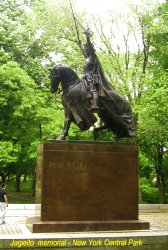
|
Biega Family Page
|
Computer Help
Special characters.
Viruses, Web pages
|
|
Central Europe
Cities, Countries, Info.
New!
|
|
History
Genealogy, History Essays New!
|
Maps
Cities, Countries, Historical
|
Museum AK
Museum of Polish Home Army
|
Photo Gallery
Poland, Warsaw, Cracow, Salzburg, Budapest
|
Rydzyna
Castle and School
Sulkowski Foundation
Hotel
|
Sailing
all over the world
|
Syrena Press
13 Is My Lucky Number
Story of fighter in Warsaw Uprising in WW II
|

|
|
Contact us by Email
|
|
600 years ago, on July 15, 1410, the Battle of Grunwald took place. The expansion of the warrior Teutonic Knights into Slavic and Baltic lands was halted by the combined Polish and Lithuanian armies under the command of Wladyslaw Jagiełło, king of Poland and Grand Duke of Lithuania (Jogaila in Lithuanian). 
This battle had major historic significance and is named Žalgirio mušis in Lithuanian, Schlacht von Tannenberg in German. The Knight's commander, Grand Master Ulrich von Jungingen, was killed together with many of the knights, others were taken prisoner. Although the Polish and Lithuanian forces failed to capture the Knight's main castle, Marienburg, the Knights never recovered their former power. The German advancement eastward was halted until the end of the 18th century and the partitions of Poland by the Prussians, Russians and Austrians.
Background
The Order of the Teutonic Knights was formed in Palestine during the Third Crusade in the 12th century. After the defeat of the Christians in the Middle East, the Order moved to central Europe to Transylvania. In 1230, Grand Master Hermann von Salza was invited by the Polish Duke Konrad I of Masovia to help Christianize the Baltic Old Prussians that continually harassed villages in Masovia (Mazowsze). This was a fatal mistake because the Order then created the independent Monastic State of the Teutonic Knights in the conquered territory, and built the huge castle of Marienburg (Malbork in Polish). Subsequently they attacked the pagan Lithuanians as well as Polish Pomerania and Kujawy.
In Poland the last of the Piast kings of Poland, Casimir III the Great, died childless in 1370. The throne was given to the husband of Casimir's sister Elizabeth, Louis I of Hungary. When Louis died, the Polish magnates elected his youngest daughter Jadwiga as Polish sovereign. In 1384 she was crowned as KING (there was no provision in Polish law for a reigning queen) at the age of 10. She was already well educated and spoke several languages.

In the meantime the Knights continued to attack Lithuania and established a stronghold in Livonia (present day Riga). Both Poles and Lithuanians sought an alliance to fight off the German threat. In August 1385, at the castle of Kreva (currently in Bialorus), Grand Duke Jogaila signed an agreement to bring western Christianity to all Lithuanians, to restore to Poland regions that had been lost earlier, and to attach Lithuania to Poland in a personal alliance.
In February 1386 he was baptized in Cracow's Wawel cathedral. Two weeks later he married Jadwiga and was crowned king of Poland with the name Władysław Jagiełło. Mass baptisms of Lithuanian nobles and people were performed during the following years.
In 1387, Queen Jadwiga personally led two military campaigns to reclaim the province Red Ruthenia (present day western Ukraine), which had been occupied by Hungary. In 1389 she died as a result of complications in childbirth (the child also died). Subsequently Jagiełło married Anna of Celje, granddaughter of Casimir III.
 The Christianization of Lithuania removed any justification for "conversion" campaigns by the Teutonic Knights. Regardless, they continued their attacks, taking advantage of disputes between various Dukes of Lithuania, and Lithuanian wars in the east against the Mongols, to occupy a large area along the Baltic coast. The Christianization of Lithuania removed any justification for "conversion" campaigns by the Teutonic Knights. Regardless, they continued their attacks, taking advantage of disputes between various Dukes of Lithuania, and Lithuanian wars in the east against the Mongols, to occupy a large area along the Baltic coast.
Finally in 1409 Grand Duke Vytautas assembled an army of Lithuanians, Tartars and even some Russians, and joined the Polish king's army in a campaign against the Knights. The combined forces were successful in the great Battle of Grunwald and destroyed the entire Teutonic army. This removed the German threat for the next 300 years.
Aftermath
The resulting union of Poland and Lithuania created the largest country in Europe of the 15th century, stretching from the Baltic to the Black Sea and encompassing all of present day Latvia, Bialorus, Ukraine and a part of north-western Russia. This was the Golden Age of Poland.
Throughout Poland and Lithuania great palaces, cathedrals and schools were built, towns thrived. Even in smaller towns building activity and prosperity resulted. In the Biega home town of
Mrzygłód a church was built using German prisoners of war. It still exists today and will be celebrating its 600th anniversary this fall.
Almost every town in Poland has Grunwald and Jagiełło monuments. Needless to say, they were all destroyed during the Nazi occupation of Poland in World War II. After the war they were recreated from photographs. The largest of them, shown above, is located in Cracow.
A statue of King Wladyslaw Jagiello stands in Central Park, close to he Metropolitan Museum. It was presented to New York in 1939 after the World's Fair.
NOTE: In World War I, in 1915, another Battle of Tannenberg took place close by. The German army almost completely destroyed the Russian army, leading to the revolution of 1917 and the rise of the Soviet Union.
In World War II, a failed attempt to assassinate Adolf Hitler occurred close by, in the bunker of Hitler's command post.
|
|






